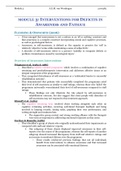Samenvatting
Summary Module 3 needed to complete quiz 3 'Neuropsychological Rehabilitation' UVT (You'll need module 4 too!)
- Instelling
- Tilburg University (UVT)
IMPORTANT! To complete Quiz 3, you'll need module 4 too! All the information needed of module 3 to complete quiz 3 of the course 'Neuropsychological Rehabilitation' at Tilburg University. This summary contains all the articles and book chapters, and also the most important information mentio...
[Meer zien]




